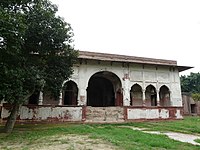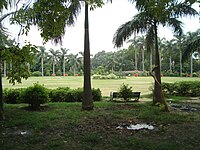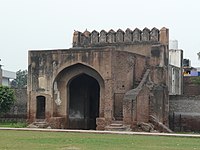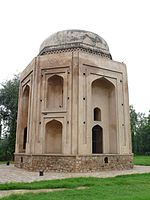-
The Sheesh Mahal at Shalimar Bagh, Delhi.
-
The Parterre and shade trees.
-
The garden pavilion.
-
The Badli Sarai were Caravanserai in the vicinity of Shalimar Bagh.
-
A tomb Maqbara-E-Paik (messenger's mausoleum) in the vicinity of Shalimar Bagh.
| Shalimar Bagh, Delhi | |
|---|---|
| Shalimar Garden or Aizzabad Bagh | |
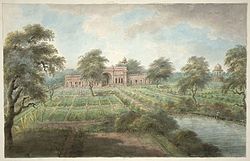 Shalimar Gardens, Delhi in 1814, showing the majestic
Parterre and Diwan Khana (visitors pavilion) in the background. | |
|
| |
| Type | Mughal garden |
| Location | Delhi, India |
| Coordinates | 28°43′14″N 77°09′15″E / 28.72056°N 77.15417°E |
| Area | 6 hectares (15 acres) |
| Opened | 1653 |
| Founder | Izz-un-Nissa wife of Mughal emperor Shah Jahan |
| Owned by | Archaeological Survey of India |
| Operated by | Archaeological Survey of India |
Shalimar Bagh also known as Shalimar Garden is a Mughal garden located on the banks of Yamuna river in Delhi, India. It was named as Aizzabad Bagh when the garden was laid by Izz-un-Nissa wife of Mughal emperor Shah Jahan in 1653 as a tribute and replica of Shalimar Bagh, Kashmir, laid by erstwhile Mughal emperor Jahangir in 1619, the Shalimar Bagh of Delhi is now abandoned but still houses shade trees, majestic parterre and structure such as Sheesh Mahal and the garden pavilion.
History
In 1653 Izz-un-Nissa popularly known by the title "Akbarabadi Mahal" the third wife of Mughal emperor Shah Jahan commissioned Aizzabad Bagh ("later renamed as Shalimar Bagh") in the then vicinity of Shahjahanabad (present-day Old Delhi). Within the Shalimar Bagh, Shah Jahan constructed "Sheesh Mahal" (crystal palace). [1]
The Shalimar Bagh had witnessed events of historical significance such as in 1658 the coronation ceremony of Aurangzeb took place at Sheesh Mahal. In 1738 en route to massacre Delhi Nadir Shah along with his army encamped here. In 1803 Sir David Ochterlony a British Resident to the Mughal court at Delhi, selected Shalimar Bagh as his summer residence. During the Indian Rebellion of 1857 a battle was fought in very place when Delhi was sieged by the troops of East India Company. [2] [3] [4] [5] [6]
In the Third Battle of Panipat, Ahmad Shah Durrani stayed here.
Design
This pavilion was built by the Mughal emperor Shah Jahan. Like most Mughal gardens, it had channels of water culminating in ornate tanks and several fountains. The layout is designed in the mughal style of chaharbagh style. The pavilion has patches of wall-paintings that survived till date. [1]
The Sheesh Mahal (crystal palace) is built on a high plinth facing the parterre with 25 fountains and the surrounding garden consisted of fruit orchards. The archways are circular, the central hall consists with a compartment at either end and an arched hall at the rear. Attached to the main building are vaulted rooms. Painting marks exist on the ceiling. [1] [7] [8]
Further reading
- The meaning of "Shalimar", The Express Tribune, Khaled Ahmed, 25 January 2012
- इतिहास की कहानी सुनाता शीशमहल, (in Hindi) Navbharat Times, 13 November 2010
Gallery
References
- ^ a b c "Sheesh Mahal". Indira Gandhi National Centre for the Arts. 2021. Retrieved 16 June 2021.
- ^ Smith, R.V (24 April 2016). "New life to old baghs". The Hindu. Retrieved 14 June 2021.
-
^
Annual Progress Report of the Archaeological Survey of India, Panjab and United Provinces, for the Year Ending.
University of Minnesota (19 December 2012). 1903. Retrieved 14 June 2021.
{{ cite book}}:|work=ignored ( help) - ^ Dua, Rohan (13 February 2020). "Aurangzeb's 'coronation site' to get facelift in Delhi's Shalimar Bagh". The Times of India. Retrieved 14 June 2021.
- ^ Das, Alokparan (25 April 2010). "Messengers mausoleum". The Indian Express. Retrieved 14 June 2021.
- ^ Smith, R.V (14 January 2016). "The rise and fall of the crazy star". The Hindu. Retrieved 20 June 2021.
- ^ "Sheesh Mahal" (PDF). Indira Gandhi National Centre for the Arts. 2021. Retrieved 16 June 2021.
- ^ "शीशमहल की बदहाल स्थिति पर हाई कोर्ट ने मांगा जवाब" (in Hindi). Dainik Jagran. 1 November 2017. Retrieved 16 June 2021.
